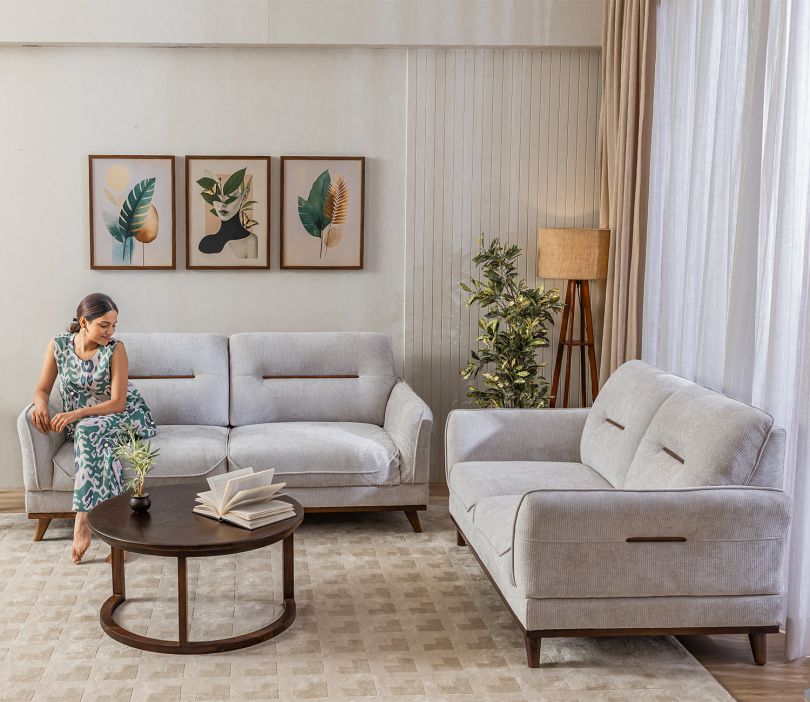How to Match Your Sofa with Interior Themes

Your sofa is more than just a piece of furniture—it’s the anchor of your living space, the spot where you unwind after a long day, entertain guests, or spend quality time with family. That’s why selecting the right sofa isn’t just about comfort or size—it’s also about how well it complements the interior theme of your home. A sofa that fits seamlessly with your interior style elevates the entire room, tying all design elements together into a unified aesthetic.
In this guide, we’ll explore how to match your sofa with popular interior design themes to help you create a cohesive, stylish, and inviting living area.
1. Understanding Your Interior Theme
Before choosing a sofa, identify your overall interior design style. Are you going for a minimalist, modern look? Do you prefer the warmth of rustic interiors or the elegance of a classic vintage space? Knowing your theme will help narrow down options based on shape, color, fabric, and even the type of legs or detailing.
Here are some common interior styles and their core features:
- Modern: Clean lines, neutral tones, metal or glass elements
- Minimalist: Simplicity, monochrome palettes, uncluttered look
- Traditional: Rich colors, classic patterns, wooden finishes
- Rustic: Earthy tones, raw materials like wood and leather
- Scandinavian: Light colors, natural wood, functional design
- Industrial: Exposed elements, leather, metal, dark hues
- Bohemian: Eclectic, layered textures, bold patterns
Once your interior style is identified, it becomes easier to choose a sofa that will fit naturally into the theme.
2. Choosing the Right Sofa Style
Each theme pairs well with certain sofa designs:
- For Modern Interiors:
Go for sectional or L-shaped sofas with clean edges and sleek finishes. Materials like leather or high-quality synthetic fabric in gray, black, or white work well. Look for chrome or metal legs for a modern touch. - For Traditional Spaces:
Opt for classic silhouettes like Chesterfields or camelback sofas. Rich fabrics such as velvet or premium cotton blends in deep tones—like maroon, navy, or olive—can enhance the vintage charm. - For Rustic Interiors:
Wooden frames and warm-toned leather or earthy fabrics fit perfectly. Choose sofas with a handcrafted look or visible wooden elements to highlight rustic aesthetics. - For Minimalist Homes:
Stick to neutral colors—white, beige, gray—and avoid excess patterns. A mid-century modern or boxy design without tufting or embellishments can align with minimalist principles. - For Scandinavian Themes:
Select light-colored fabric sofas with wooden legs, often in soft beige, pastel, or grey tones. Simplicity, comfort, and function should guide your choice. - For Industrial Style:
Leather sofas in brown or black with metal accents fit well. You might also consider distressed finishes or vintage-style designs to add character. - For Bohemian Interiors:
Go eclectic—think layered cushions, vibrant colors, and patterned upholstery. A simple sofa can be styled up with throws and boho cushions for that carefree, artistic look.
3. Color Coordination
Color plays a pivotal role in making your Sofa blend seamlessly with the room. Use the 60-30-10 rule:
- 60% of the room in a dominant color (usually walls or large furniture)
- 30% in a secondary color (like rugs or curtains)
- 10% in an accent color (cushions, lamps, or décor pieces)
Your sofa typically falls into the 30% or 60% zone, depending on its size and prominence.
Here’s how to pick sofa colors based on the theme:
- Neutral palettes (minimalist, modern): Shades of grey, white, cream, taupe
- Earthy tones (rustic, bohemian): Brown, terracotta, mustard, forest green
- Bold colors (boho, eclectic): Turquoise, pink, royal blue, burnt orange
- Classic hues (traditional): Deep red, navy, emerald, gold
- Light shades (Scandinavian): Pastel pink, sky blue, soft beige
You can also use color contrast to make the sofa a statement piece or blend it with the surroundings to create harmony.
4. Selecting the Right Upholstery Fabric
The fabric of your sofa adds not just texture, but also character to the space. Here’s how to match fabric with themes:
- Velvet: Ideal for luxurious, traditional interiors
- Leather: Great for industrial or rustic looks
- Linen/Cotton: Perfect for minimalist, Scandinavian styles
- Woven or Patterned Fabrics: Bohemian and eclectic rooms benefit from these
You should also factor in practicality—especially if you have kids or pets—while choosing the fabric.
5. Complementing with Accessories
Matching your sofa to the interior theme doesn’t stop at the sofa itself. Use cushions, rugs, throws, and even wall art to reinforce the design style.
- Scandinavian: Add knitted throws, textured cushions, and light wood accessories.
- Industrial: Pair with metal floor lamps, exposed brick walls, or vintage clocks.
- Bohemian: Mix and match colorful pillows, Moroccan rugs, and plants.
- Modern: Use abstract wall art, glass coffee tables, and chrome accessories.
- Traditional: Choose floral curtains, carved wood tables, and classic paintings.
Even a neutral sofa can feel completely different depending on how you accessorize it.
6. Proportions and Layout Matter Too
Even the best-matched sofa can feel out of place if it doesn’t fit well in the room. Ensure that your sofa’s size aligns with the scale of the room and other furniture.
- In compact apartments, a minimalist or Scandinavian sofa works better due to its airy design.
- Large living rooms can accommodate sectional or L-shaped sofas that complement modern and traditional themes.
Try using layout planning tools or tape out the sofa’s dimensions on your floor before purchasing.
7. Why Customization is Key
One-size-fits-all rarely applies to interior design. Consider brands that offer customization so you can pick your preferred fabric, color, and size. This gives you greater flexibility to align the sofa with your room’s exact look and feel.
8. Investing in Long-Term Style
Your sofa is a long-term investment, so don’t just buy what’s trendy—choose what fits your lifestyle and theme best. A sofa that reflects your personality and blends with the home’s visual language is always in fashion.
Conclusion
Matching your sofa with your interior theme is an art that blends style, function, and personality. From choosing the right style and color to selecting suitable upholstery and accessories, each element contributes to a harmonious living space. Whether you lean toward the warm charm of rustic decor or the clean appeal of modern design, the right sofa brings your vision to life.
If you’re looking for high-quality, theme-compatible sofa sets with customizable options, Wooden Street offers a wide range to match every taste and interior style.
Read more blogs on – https://theglobalnewz.com/




